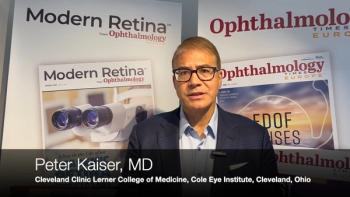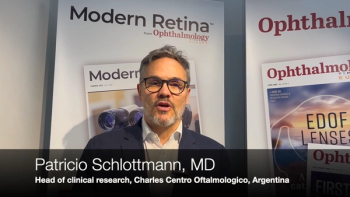
IRIS Registry study: Overall anti-VEGF injection intervals for wet AMD similar at 1, 2 years of treatment
With the widespread adoption of the American Academy of Ophthalmology (AAO) IRIS Registry (Intelligent Research in Sight), it is now possible to analyze the real-world injection intervals of patients in the United States with wet AMD who are treated with anti-VEGF agents.
Editor’s Note: This article was adapted from Dr. MacCumber’s presentation at the American Academy of Ophthalmology 2019 annual meeting, and includes data compiled prior to the FDA approval of brolucizumab (Beovu, Novartis).
Anti-vascular endothelial growth factor (VEGF) injections are widely used in the United States for the treatment of neovascular (wet) age-related macular degeneration (AMD).
Given the treatment burden of injecting these drugs on a monthly or every-other-month schedule as initially recommended, the vast majority of U.S. retina specialists (Figure 1) have moved to treat-and-extend regimens, the effectiveness of which is supported by the literature.1,2
In an ideal world, that would likely mean anti-VEGF injections given every month for a few months after initiation of therapy, followed by longer durations, for a total of 6 to 8 injections in the first year and fewer in subsequent years.
In clinical practice, numerous factors may prevent strict adherence to the intended schedule, including the basic biology of the disease in individual patients, physician factors (training, office scheduling), patient factors (concomitant health issues, difficulty with travel or family support, etc.) and health system factors (insurance constraints).
With the widespread adoption of the American Academy of Ophthalmology (AAO) IRIS Registry (Intelligent Research in Sight), it is now possible to analyze the real-world injection intervals of patients in the United States with wet AMD who are treated with anti-VEGF agents. Since its launch in 2014, the IRIS Registry has rapidly become an extremely comprehensive data resource, with 274 million patient visits representing 63 million patients and more than 15,000 ophthalmologists.
There is so much data in the IRIS Registry that it requires sophisticated data science to analyze it effectively. Verana Health-the data curation and analytics partner for the IRIS Registry-was founded by ophthalmic industry leaders to help physicians improve patient care through the power of big data. The company is helping the AAO and researchers derive new insights and accelerate clinical research.
Additionally, through Verana Practice Insights, individual ophthalmologists can get an aggregate view of physician practice trends and benchmark their individual clinical-care patterns relative to a cohort of their peers.
Wet AMD study
In collaboration with Novartis and Verana Health, my colleagues and I recently evaluated real-world injection intervals in treatment-naïve patients with wet AMD.3
The analysis included records for eyes with a diagnosis of wet AMD, at least one anti-VEGF injection during the study period (July 1, 2013 to Nov 2, 2017) and no anti-VEGF treatments during the 6 months (baseline period) preceding the first injection date (index date).
Additionally, all eyes had to have had at least hand-motion vision during the baseline period and no record of other conditions that can be treated with anti-VEGF agents (e.g., diabetic macular edema or retinal vein occlusion).
Out of more than 1.7 million patients who received anti-VEGF injections during the study period, many thousands were excluded because they were already being treated with anti-VEGF therapy, or because they had diagnoses other than wet AMD.
In all, records for 56,672 eyes of 54,392 patients met the criteria for analysis. The mean age of the patients was 81.1 ± 8.4 years and nearly 65% were female. Visual acuity at baseline was distributed around 20/80, as we have seen in other studies. About one-quarter of the eyes had worse than 20/200 acuity at baseline, which highlights the need for earlier diagnosis and initiation of treatment.
Injection intervals were determined for all eyes and compared with those treated with the branded anti-VEGF therapies available during the study period: aflibercept (Eylea, Regeneron, n = 13,467 eyes) and ranibizumab (Lucentis, Genentech, n = 9,128 eyes).
Study results
The mean number of injections per eye was about 5 per year (Figure 2). There was little apparent difference between Year 1 and Year 2 of treatment, among patients that received treatment within a given year, or between the two branded anti-VEGF agents studied. All in all, this is fewer injections annually than we might have expected.
When we looked only at eyes that were treated with one drug at the beginning and end of a full year (or 2 years), we found wide variation in injection intervals. We would expect the injection interval to be short during the initial months of treatment, and longer after the physician uses a treat and extend treatment approach.
Data show, however, that even by the end of Year 1, about 40% of eyes treated with all anti-VEGF medications needed injections more frequently than every 8 weeks (Figure 3), including 17% to 18% who still needed monthly injections. At 2 years, the pattern is remarkably similar, with minimal improvement in injection intervals, demonstrating just how chronic this disease is.
Eyes treated with the branded therapies and particularly those who received aflibercept injections, fared a little better, with lower percentages requiring treatment more often than 8 weeks (Figure 3).
Note, however, that these results should be interpreted in light of the fact that this is a descriptive study and no formal statistical analyses adjusting for differences between treatment groups were conducted.
This study did not evaluate the impact of treatment on clinical care variables such as visual acuity or retinal fluid, so we cannot determine from these results whether the injection intervals were appropriate or whether a different interval would have resulted in better or worse clinical outcomes.
Certainly, this study provides great insight into the true treatment patterns of U.S. retina specialists who subjectively favor treat-and-extend protocols but may not always achieve that in practice.
More work is needed to correlate treatment outcomes with injection intervals. As a researcher, I’m excited about the implications of partnering with the IRIS Registry for future studies. This tremendous volume of objective data provides an opportunity to better understand current treatment patterns as we explore new approaches to AMD.
Disclosures:
Mathew W. MacCumber, MD, PhD
E:
Dr. MacCumber is professor and associate chairman for research, Department of Ophthalmology, Rush University Medical Center, Chicago, and in private practice at Illinois Retina Associates, Chicago. He is a past chairman of the AAO Council and a past member of the AAO Board of Trustees. Dr. MacCumber reports consulting revenue from Genentech, Novartis Pharma AG, and Regeneron.
References:
1. Rufai SR, Almuhtaseb H, Paul RM, et al. A systematic review to assess the 'treat-and-extend' dosing regimen for neovascular age-related macular degeneration using ranibizumab. Eye. 2017;31:1337-1344.
2. Vardarinos A, Gupta N, Janjua R, et al. 24-month clinical outcomes of a treat-and-extend regimen with ranibizumab for wet age-related macular degeneration in a real-life setting. BMC Ophthalmol. 2017;17:58.
3. MacCumber M, Yu, JS, Sagkriotis A, et al. Injection intervals in treatment-naïve neovascular AMD patients who received anti-VEGF agents: An analysis of the IRIS Registry. American Academy of Ophthalmology, San Francisco, 2019:PO471.
Newsletter
Keep your retina practice on the forefront—subscribe for expert analysis and emerging trends in retinal disease management.
















































